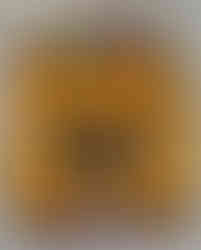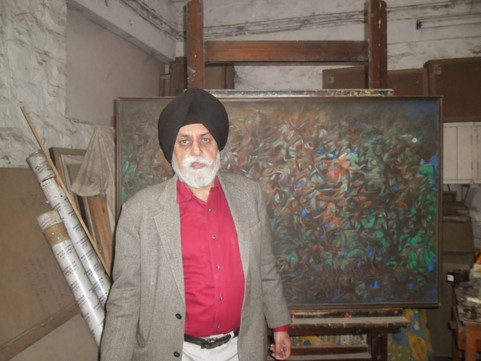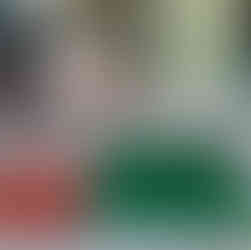Prem Singh: Lyrical Voices
- artamour

- Dec 6, 2020
- 7 min read

Prem Singh was born on 15 April 1943 in Patiala, Punjab. He studied at the Government College of Art, Chandigarh, from 1962 to 1967. He has held 25 solo shows and participated in many important national and international art exhibitions. A recipient of the Lalit Kala Akademi Triennale India International Award in 1994, he has been honoured by many State Akademi and cultural institutions in recognition of his contribution to art. His works are in the permanent collection of many museums and art galleries in India and abroad. He currently resides and works in his studio at Kaladham, Greater Noida (Delhi NCR).

Art for me is a vehicle to cycle my feelings, emotions, ideas and thoughts into a visual voice. – Prem Singh
1. When did you decide and what prompted you to become an artist? Please give a brief account of your challenges and struggles in your journey as an artist. Any role models?
PS: I was born at Patiala in British India and brought up in a joint family headed by my great grandfather Kaur Singh. Living together was a great learning experience. Men, women and children of different classes and castes lived in our street and had great feeling and concern for each other. It is in the company of elders that I learnt many things – most importantly, how to be a good human being.
Festivals and fairs were a common heritage and celebrated together. Sanjhi Mai, Dassehra, Diwali, Lohri and Holi were a source of great delight for us, the children.
As I was growing up in the streets of Patiala in the late 1940s and early 1950s, my friends had started telling me that there was an artist in me! Whenever and wherever we played, my friends would invariably ask me to draw the diagrams for the games. The word about my drawing skills spread among the neighbours. During fairs and festivals I was often asked to draw 'hoi' or other decorations. Though my parents were happy at my new-found celebrity status, in private they always scolded me that this was at the cost of my studies.
The festivals and celebrations stimulated me enough to express myself through the language of line, form and colour. It was a collective activity in which one learnt a lot from each other irrespective of age, sex or religion. Such activities were in a way reinforcing in me the presence of an artist.
Then came the incredible moment . . . the contemplative awareness awakened . . . the realization of creativity.
As a child I was quite fascinated by the image of a lion. The lion is also a favourite cultural motif. I saw the lion in clay toys, embroidered phulkaris, woven durries, paintings on the walls, and paintings by Western artists in the palaces of Maharaja of Patiala. None of these lions were similar, and yet they were all lions. This gave me the impetus to create my own lion. Since then I have been in the quest for my own lion.
Art is a journey, performed in a given time and place. Challenges and struggles are stimulants and test one's ingenuity. Creativity is in itself a role model for me.
The lion weaved on a bag by the artist’s mother, Mohinder Kaur
2. What art project(s) are you working on currently? What is your inspiration or motivation for this?
PS: Painting, for me, is an ongoing activity. I don't frame my art into projects.
Nature seems like an inexhaustible resource. It remains a major source of inspiration for humanity and whose divine and celestial chorus is ever rejuvenating. My paintings reflect on such playful and prayerful moments that I experience through my dialogue with the manifest and the unmanifest in nature.

Lyrical Voices 1, Oil on canvas, 70 inches × 35 inches, 2019-2020

Lyrical Voices 2, Oil on canvas, 70 inches × 35 inches, 2019-2020

Lyrical Voices 3, Oil on canvas, 70 inches × 35 inches, 2019-2020

Lyrical Voices 4, Oil on canvas, 70 inches × 35 inches, 2019-2020

Lyrical Voices 5, Oil on canvas, 70 inches × 35 inches, 2019-2020

Lyrical Voices 6, Oil on canvas, 35 inches × 25 inches, 2019-2020
3. Contemporary art has become very diverse and multidisciplinary in the last few decades. Do you welcome this trend? Is this trend part of your art practice?
PS: Art, since the middle of the nineteenth century, has undergone many revolutionary changes. Change is an unchangeable law of nature. Art is expression. Diversity and its multi-dimensional nature are inbuilt in it. Freedom is the key to expression. Inevitability of change in expression is the beauty and strength of art.
Art, for me, is like a river that permanently flows and takes its own course.
Yes, I appreciate this change and welcome it wholeheartedly. Trends may come and go. I don't follow trends. I only listen to my inner to give it a visual voice. Let art HAPPEN!
4. Does art have a social purpose or is it more about self-expression?
PS: Yes, art is self-expression. It begins with the human experience and also ends with it. A work of art is created to be seen and shared. A painting is not created with methods but is expressed by the artist's soulful visions. In our 'shastras' it is mentioned that paintings are the greatest treasures of mankind as they have the aura and power to beneficially influence the minds and lives of the viewers. It is also acknowledged as more valuable than gold and jewels. A work of art mirrors the spirit of the time and place in which it has been created.
Art, for me, is one of the vital means of seeking relationships with people. Its purposefulness and social significance in the lives of the people is highly valued and it is also a process to refine the human species.

November 1984 and its aftermath 1, Ink drawing, 1984

November 1984 and its aftermath 2, Ink drawing, 1984

November 1984 and its aftermath 3, Ink drawing, 1984

November 1984 and its aftermath 4, Ink drawing, 1984

November 1984 and its aftermath 5, Ink drawing, 1984

November 1984 and its aftermath 6, Ink drawing, 1984

November 1984 and its aftermath 8, Oil on canvas, 28 inches × 34 inches, 1984

February 2020 Delhi 1, Ink drawing, 2020

February 2020 Delhi 2, Ink drawing, 2020

February 2020 Delhi 3, Ink drawing, 2020
5. Where do you create your art (workplace / studio)? What is your process?
PS: My art journey spans a period of almost six decades. I have spent 35 years serving on the faculty of Government College of Art, Chandigarh. During this time I have been painting either at home or the space provided by Punjab Lalit Kala Akademi in its Kala Bhavan premises. After my retirement in April 2001, I moved to Delhi's Garhi Studios and shared a studio with another artist, Nand Katyal. Later in 2014 I shifted to my own studio in Kaladham, Greater Noida, where I am living and working full time now. There is no better pleasure than expressing one's self. A studio is a sacred place where an artist meditates and expresses his soulful vision in all its divine purity. Creating a work of art is a pious act. In hours of uninterrupted solitude an artist gets in tune with his creative self and gives his emotions, feelings and thoughts a visible voice by using his skills and imagination.
What I seek in my artistic expressions is silent activity not easily discernible to the eye but can be experienced in contemplation. In such moments of creativity my whole being is transformed into a plant that grows every minute by remaining firmly rooted to the soil.
This feel of eternity and silent activity gives wings to my imagination. And that inspires me to tune the rhythmic voice and its subtle nuances in consonance with my heartbeat. An organic feel of the silent activity of nature, intensive chirping of the birds in the low light of morning and evening, the transcendental music of light – all this and much more is an integral part of my creative quest. It's my humble attempt to 'grasp' joy and life as they fly.

Working in Chandigarh
At Garhi studio No. 6
At Kaladham, Greater Noida
6. To what extent will the world of art change in the post-Covid period – both in terms of what is created as also the business of art?
PS: Covid-19 was first identified in Wuhan, China, in December 2019. The WHO declared it a global pandemic on 11 March, 2020. The Government of India took 13 days to think and four hours to enforce the lockdown on one billion plus population with a promise to counter, control and conquer Covid-19 within 21 days. The poorly planned and cruelly executed lockdown resulted in irreparable losses of human lives and resources.
The outbreak has not only sent life topsy-turvy but has also shaken the world economically. The world of art has been severely affected. All activities have come to a stand still by the closing of galleries, museums and all other institutions related to art. In this period of self-isolation and social distancing, the impoverishment of our apex and state bodies towards its role of taking care of the artist fraternity has been blatantly exposed.
Though it is too early to gauge the post-Covid situation, one only hopes that we will be able to recover from the huge losses and think of putting our lives back on track once we are able to overcome the pandemic. One thing that is certain is that Covid-19 and its devastating effect on the life of the people will continue to haunt us and reflect in our creative arts at least for some time. Since art is a creative spirit, it cannot be quarantined. In such stressful times art serves as a therapy both for the artist as well as for the viewer. The pandemic gave the artists a time for self-introspection. Intrinsic motivation has led many artists to create significant works of art during their time. Sometimes good comes from adversity.
One thing which we must always remember is that Covid or no Covid we are one world and need to heal and love each other.
7. Tell us about any other interest you may have besides your art practice . Does it get reflected
in your art?
PS: Interacting with children is dear to me in many ways. I also firmly believe that as long as the child is alive in me, I am an artist. The day it ceases to exist within me, I don't think that I will be able to paint anymore.
Moreover, artists are generally familiar with academic or ethereal proportions. We are ignorant about the proportions that a child applies through his likes or dislikes while painting. The friend dearest to the child would be painted the biggest in the painting as compared to other objects and figures around. This is where I admit to have learnt from the children a lot in my journey of art.
Travelling to different countries and interacting with their cultures interests me the most. The enhancement and enrichment that I gain through such encounters does reflect in my art.
(All images are courtesy of Prem Singh.)
The artamour questionnaire is a regular series of interviews with visual artists across disciplines, who share their views about art, their practice and their worldview on a common questionnaire template. Like, comment, share and subscribe to stay updated.


















Kabar4d merupakan penyedia game slot paling populer dengan tingkat rtp diatas rata - rata. Dapat dan mainkan sekarang hanya bersama kabar4d!